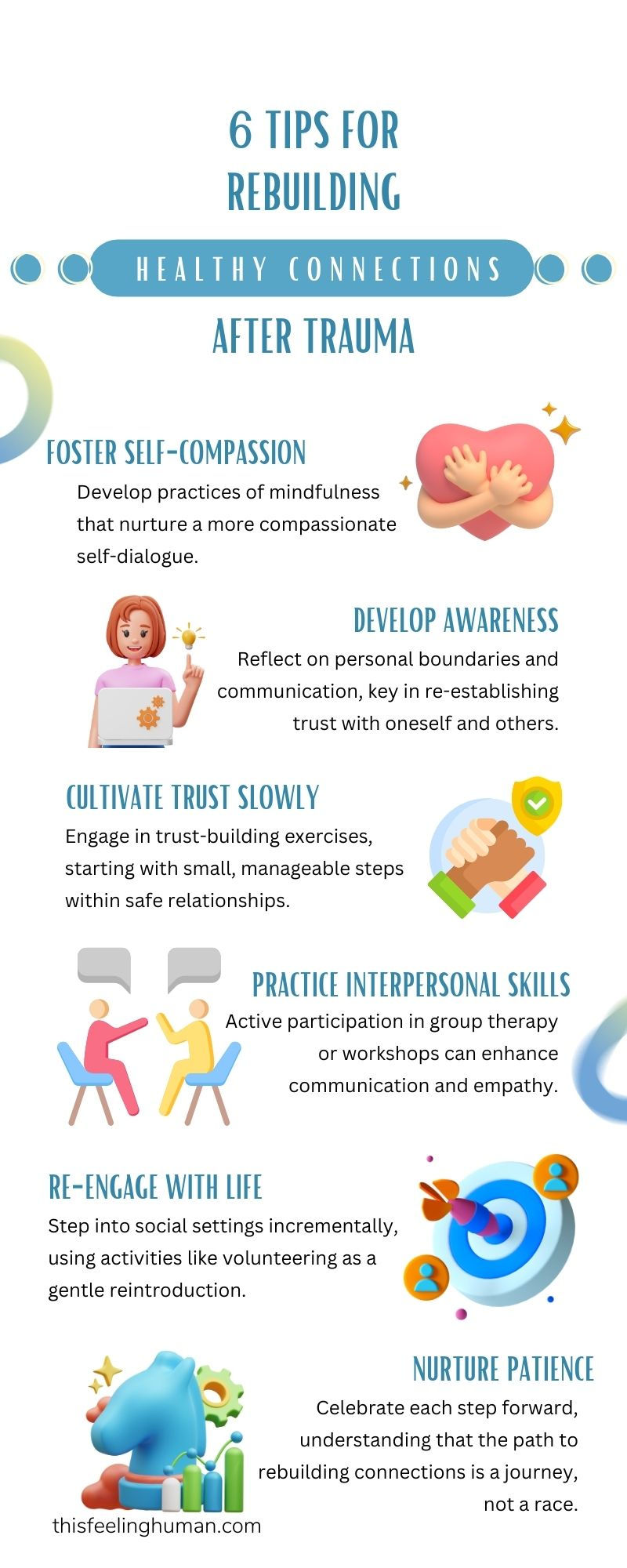Healing Through Reconnection | Embracing Vulnerability to Rebuild Trust
- TFH

- May 13, 2024
- 5 min read
Updated: Aug 7, 2024
The journey toward healing from trauma is profound and deeply personal, placing at its heart the pivotal role of re-establishing connections—not just with those around us but with ourselves. At the core of this healing process lies the building of secure attachments and the nurturing of a supportive community, a pursuit that, while challenging, is deeply transformative.
A Gradual Path to Vulnerability and Trust
Healing is not an overnight process, nor does it follow a linear trajectory. It begins with small, yet significant steps toward embracing vulnerability and re-learning to trust—ourselves and others. This journey navigates at one's own pace, recognizing that each moment of vulnerability is a step towards building a sturdier foundation of trust.

Tips for Cultivating Connections and Building Trust:
Practice Self-Compassion: Begin by fostering a compassionate dialogue with yourself. Acknowledge your pain and permit yourself to heal, understanding that healing is a journey that requires patience and kindness.
Seek Supportive Relationships: Surround yourself with people who offer empathy and understanding. Whether it's friends, family, or therapeutic relationships, seek out those who encourage openness and share your values of healing and growth.
Embrace Vulnerability on Stages: Recognize that becoming vulnerable is a risk that comes with the potential for reward. Start small with trusted individuals and gradually allow yourself the space to share more, as comfort allows.
Cultivate a Sense of Belonging: Involve yourself in communities where you can share experiences and receive support. Group therapy, support groups, or community-based activities can offer a sense of belonging and a shared journey.
Reconnecting with Self and Others Using Emoli Cards
Understanding the story behind our emotions is crucial for self-acceptance and healing. This aspect is often overlooked in our typical handling of emotional experiences, both pleasant and distressing.
Each emotion carries an important narrative, which inspired me to write the free ebook titled My Guest House. Over the past four years, I’ve learned that emotions have a purpose and invite us to explore our deep-seated thoughts and beliefs.
To help readers better understand their emotions, we partnered with The School of Emotions to promote Emoli Cards for emotional literacy. Every emotion has a story, an impulse, and a purpose.
Often, we find ourselves reacting without understanding the underlying story of our emotions, leading to self-blame and the need to calm down. However, how often do we approach our emotions with curiosity and without judgment?
This is why we provide Emotion-Based Coaching. By using a combination of Emoli Cards to uncover the narratives of our emotions, Calm3D for immersive mood regulation, and life coaching sessions, we help our clients understand what their emotions are conveying. This approach acknowledges the collection of memories and beliefs that influence our actions and reactions, paving the way for deeper self-awareness and genuine connections with others.
The Transformative Power of Connection
In forging paths from trauma to healthy relationships, we rediscover the transformative power of human connection. Within the collective embrace of supportive communities and the security of rebuilt attachments, the shadows of past traumas are chased away, replaced by the warm light of hope and deeper connection.
Initiate Comfortable Social Interactions: Start by engaging in social activities that don’t necessarily focus on your trauma but are instead centered on building positive interactions.
Consistent Communication: Establish regular check-ins with close friends or family members as a way to foster a sense of stability and continuity in your relationships.
Be Mindful of Boundaries: Recognize and respect both your boundaries and those of others. Healthy boundaries are the cornerstone of secure and respectful attachments.
Secure attachments and supportive communities are not mere buffers against the trials of existence; they are vital grounds upon which a new life can be envisioned—one of connection, personal growth, and enduring resilience. Through the act of reconnection, we don’t just mend the past; we carve out a future rich with possibilities for joy, intimacy, and a profound sense of belonging.
The Unseen Struggle: Finding Relief in Acknowledgment
When it comes to human emotions, pain often hides in the shadows, felt but unseen. It's a journey that's not just about dealing with the pain itself, but also about making it visible to ourselves and others. For many of us, relief begins with a simple act of acknowledgment. It's not about finding a solution or escaping the pain but about someone recognizing that our pain is real. That's when the invisible pain starts to become visible.
Acknowledging the Pain: The First Step Toward Healing
For those carrying the weight of unseen wounds, the journey toward healing often feels like navigating through a fog—a constant search for something just out of reach. The pivotal moment, however, arrives when there's a shift in perspective, a gentle yet profound acknowledgment of what has happened and of the pain that lingers, often silently.
Embracing Vulnerability
Acknowledging our pain requires a deep sense of vulnerability. It's about allowing ourselves to see our wounded parts, to touch the tender spots in our hearts and say, “This is real. This hurts.” It's a declaration that can be as terrifying as it is liberating, for it means confronting our pain head-on, without the armor we’ve meticulously built around it.

The Power of Naming Your Pain
There’s profound power in the simple act of naming what we’re going through. In doing so, we begin taking back control and defining our experiences on our terms. This doesn’t mean that the pain immediately diminishes, but rather that we start to see a path through it—a path that acknowledges the pain’s presence but also our resilience and capacity to seek healing.
Finding Relief Through Recognition
Once the pain has been acknowledged, a subtle yet significant shift begins. It is as if by shining a light on the darkest corners of our experiences, we allow ourselves space to breathe, to feel, and to eventually heal. The acknowledgment doesn’t erase the pain, but it does begin to loosen its grip, revealing pathways to understanding and, ultimately, relief.
The Role of Shared Experience
One of the most comforting aspects of this journey is the discovery that we are not alone. In sharing our stories, we find others on similar paths, and there's immense relief in discovering that our pain, while unique in its impact, is not entirely ours to bear alone. The shared experience creates a fabric of understanding and mutual support, a reminder that in our vulnerability lies our greatest strength.
Reframing the Narrative
As we acknowledge our invisible battles and share our truths, we also begin the process of reframing our narrative. No longer do we see ourselves as mere victims of circumstance, but as individuals capable of facing our challenges head-on, with grace and resilience. This narrative shift doesn’t discount our pain but allows us to view it through a lens of potential growth and healing.
Towards the Path of Healing
Acknowledgment is but the first step on a long road to recovery—a road marked by setbacks and victories, tears and triumphs. As we venture forward, the act of recognizing our invisible pain becomes a beacon, guiding us through the darkness toward a place of understanding, compassion, and, ultimately, relief.
For anyone walking this path, remember that your pain, though invisible, is valid. And in acknowledging it, you take the first, most crucial step toward a future where relief is not just a fleeting moment, but a lasting presence in your journey toward healing.


Comments